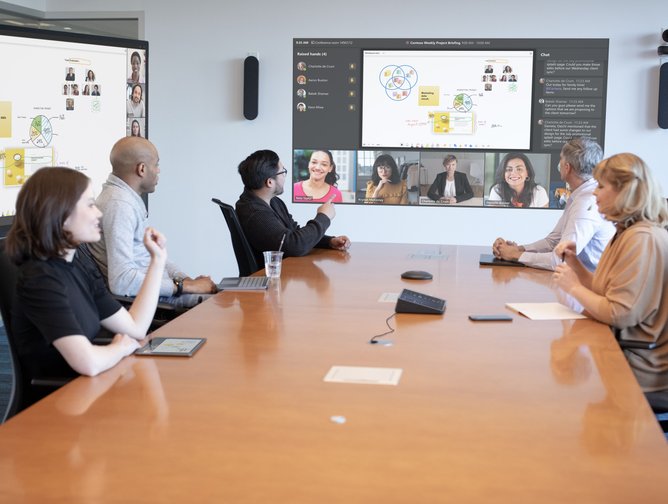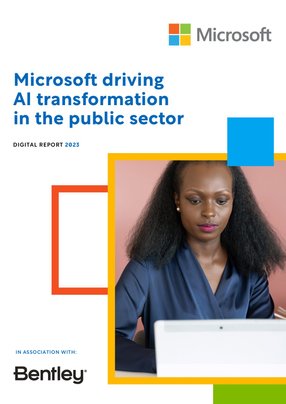Microsoft driving AI transformation in the public sector
When one thinks of ‘Technology Leaders,’ Microsoft is likely the first company that comes to mind.
A globally recognised brand offering a wide portfolio of products and services across industries, central to Microsoft’s message is its mission of empowering every person and every organisation on the planet to achieve more.
“For me, we're so much more than a large technology company,” describes Greg Wilson, Government CTO at Microsoft’s Worldwide Public Sector team. “There's a responsibility on us as a strategic partner to nations, and as a partner to governments. We're thought leaders in terms of Cloud technology. Although we also have a responsibility for helping governments understand how things like AI should be governed, or how to help reduce the digital divide, or how to support sustainability commitments and how to work with our big partner ecosystem.”
Microsoft is truly leading the AI revolution, from its Copilot products to Azure OpenAI Service and Cloud adoption, which helps improve productivity, insights and driving automation. The use cases in the public sector, as well as other areas, are endless.
“There's one word that's driving this change and that's AI,” Wilson describes. “The other word that's completely underpinning that, of course, is data. The AI revolution of Microsoft, particularly over the last few months, has built up on all the work that's been done over the last 10 years and how we're going forward. Today, we've restructured our Government Industry focus to be more about empowering governments with technology to help solve society’s biggest challenges with AI in the Cloud.
“I think it's beholden to us as we bring all this new tech to the market space to help governments understand it, help our partners understand it, and really demystify it for governing bodies so they understand the tech, they understand the issues, they understand the risks and they understand accountability.”
The key drivers for tech adoption in the public sector
With the world now in an era of AI transformation, Wilson's message for organisations is to not get left behind. “We can talk about generative AI and all the great things that these tools enable, but all the magic starts with the hyperscale cloud.” As a result, a lot of discussions around AI transformation are centred around moving governments to the cloud. “The Cloud is where the magic is unlocked and for governments wanting to better understand their data and access emerging technologies like AI and quantum, migrating to the cloud is a key first step,” Wilson says. “Here they will unlock the power of solutions like Microsoft Fabric that will reshape how everyone accesses, manages, and acts on data and insights by connecting every data source and analytics service together—on a single, AI-powered platform. Or our Copilot products that use AI tools to help users to unleash a whole new way of working. Copilot works alongside you to unleash your creativity and help you perform tasks faster. It's amazing and Copilot will help you organise ideas, understand context, and bring collaboration to a whole new next level.
“People expect their governments to change,” Wilson asserts. “They expect the services that are getting to go online and therefore they're expecting their country to adopt a more competitive approach in the digital market. We can see the clear benefits this brings to society through efficiencies, reducing costs, improving customer satisfaction, and even driving innovation going forward.”
Driving this innovation, Microsoft is accelerating how customers can improve employer productivity and leverage transformation AI by going to the cloud. “This is the massive impact that will empower governments, with our technology, to help solve society's biggest challenges. It'll deliver innovation in programmes and experiences. It will better empower the government workforce and we will see a transformation of the business space in terms of especially government operations and services.”
The need for ethical AI
As AI technologies become increasingly integrated into public life, ethical considerations are paramount. “The challenge obviously always in the public sector is that procurement cycles are longer,” Wilson describes. “There's no hesitancy; they want to get after AI. It's beholden on us to help them understand its utility, how to contract for it, and how to ensure that the benefits are reaped responsibly.”
In line with these responsibilities, Microsoft has developed ethical principles around AI since 2018. “In short, we must ensure our view that AI is always under the control of humans: that's a first order of priority for governments and ourselves alike. That connects directly with the essential concept in a democratic society, that one of our founding principles is that no person is above the law, no government is above the law, no company is above the law and therefore no product or technology should be above the law.
“Therefore, the people who design and operate AI systems cannot be accountable unless some of these decisions are subject to the rule of law,” Wilson adds. “We're doing a lot of work with governments that help them understand their AI policies, advance the regulatory debate and explore how a government can ensure what regulations and policies they should take forward.”
The importance of cybersecurity
With over 10,500+ security and threat intelligence experts worldwide, Microsoft provides governments with valuable insights on cybersecurity. The company synthesises 64 trillion signals daily, uses sophisticated data analytics, and has AI algorithms to protect against cyber threats.
“Our technologies around the world connect billions of customers,” Wilson describes. “This gives us a rather unique advantage of being able to aggregate security data, and to understand the scope and scale of digital threats around the globe.”
With such diverse threats coming in from many sources, it would be difficult for customers to anticipate when they may be attacked and how to defend themselves. To combat this threat, Microsoft uses sophisticated data analytics and AI algorithms to understand and protect against threats and cyber-criminal activity. “We synthesised 65 trillion signals a day, blocked more 4,000 identity attacks per second and tracked 300+ threat actors last year alone and we removed up to 100,000 domains, which were being used by cyber criminals and, in some cases, nation state actors.
“It's important for us to help people and governments understand, particularly policy makers, how we help them with their security cyber policies and resilience,” Wilson comments. “Cybersecurity is of national importance not just to economies but is a priority for the governments around the world, to make sure that their capabilities and their data is safe.”
Partnership with Bentley Systems
Partnerships are key to Microsoft’s success. Wilson cites partnerships like that with Bentley Systems, which enable the development of new digital twin and smart city solutions. “We have our own products, but our products are there to help our really extensive partner ecosystem,” he says. “In my area, smart cities and critical infrastructure, Microsoft doesn't build bridges or railways, but our technology helps those firms that do.”
“With a strategic partnership like the one of Microsoft and Bentley Systems – a leader in engineering software for professionals to design, build, operate and maintain critical infrastructure, such as roads and rail networks, or public works and utilities – it enables us to develop new smart city solutions and that builds a lot on some of the exciting work we're doing in Digital Twins.”
These Digital Twins can help in a number of ways: reducing costs, helping with urban planning, and driving public engagement in projects such as high-speed rails or dams. “It is just amazing how that work can be done with Digital Twins. I like watching Formula One racing, but actually the most valuable racing car is the Digital Twin racing car, because that's the place where the teams can test numerous different scenarios and take them forward without destroying physical assets.
“For me, these opportunities – particularly as we go more to the industrial metaverse and how we see the industrial metaverse in Digital Twin and the sensors of IoT sensors all coming together – will be somewhere where our expertise and the expertise of our partners such as Bentley will come together, making a real and huge difference to business and mission outcomes.”
Look to the future
Looking towards the future, Wilson predicts that the pace of technological change will only accelerate. “Change has never been as fast nor will it ever be as slow again as it is today, that is widely recognised,” he reflects.
“The pace of AI change that we are seeing is absolutely tremendous. This is not a hype or a trend, this is making a real impact and changing the way that AI goes forward and evolves.”
In addition to the rise in AI, Wilson highlights other next-gen technologies from 6G networks to robotics and the metaverse.
“When you think about some of the networking technologies that are changing, we're getting to the early stages of 6G. How can we take that technology further to the edge, to the frontline worker, particularly in public safety and justice, healthcare, and critical infrastructure.
“And I think with the pervasiveness of computing, we'll see a drive for more and more low-code, no-code applications, people doing their own things to advance public services.”
Despite some scepticism in recent months, Wilson also believes the metaverse will come to the fore.
“The infrastructure is there, the technology's there, the AI is there, and industrial metaverse and smart cities will be a big driver. Then you throw on top, quantum computing – in particular, what we're doing in the research area at the moment and how that will become more prevalent in driving decisions from data.”
Ultimately, Wilson explains that, for public sector organisations, it is beholden on them to understand all these technologies as they move forward. “We're working with some of the Government research organisations around the globe and international think tanks, as well as with academia helping them drive forward technological innovation and helping them understand:
“What government services can be improved? What does this mean for how they use digital technology smarter for their environmental position and services? And then really, where can we use quantum to drive things forward?”
“Underpinning everything, whether it's now or in the future, are those points of security and trust and what that means when you adopt new technologies,” Wilson concludes.
“The horse got replaced by the car, how do we translate that analogy as we go forward with AI? I think it's beholden on us all to think these things through for the public sector responsibly as change is continually and needs embracing and considered strategically not reactively.”






